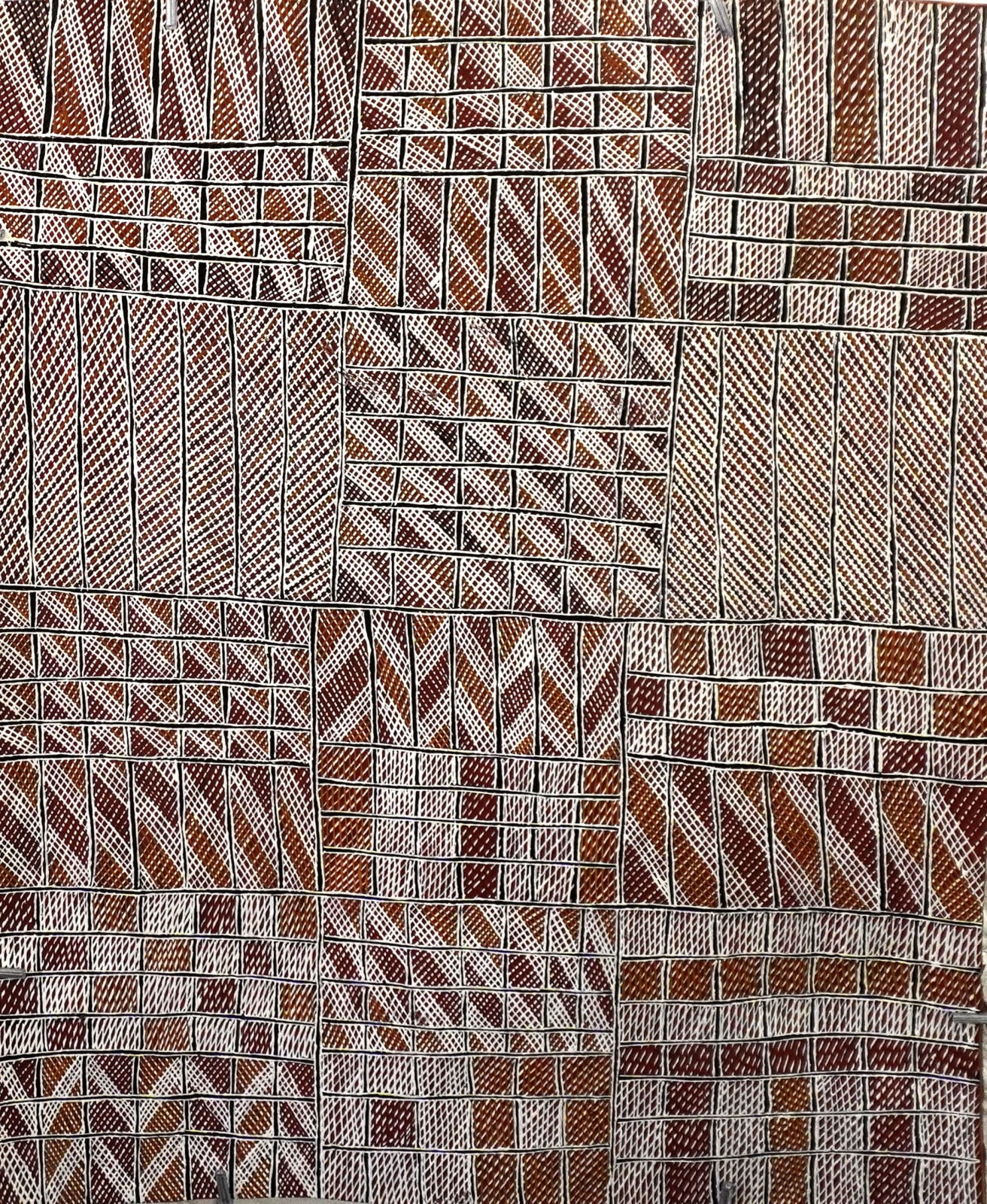Milpurr Munuŋgurr Yaŋgarr
Djapu ga Dhudi-Djapu, 2025
Earth pigments on Stringybark
72 x 50 cm
2383-25
The cross hatching grid pattern is the sacred design for the freshwaters of the Djapu clan at their homeland Waṉḏawuy, now an outstation about 150 kilometres south of Yirrkala and...
The cross hatching grid pattern is the sacred design for the freshwaters of the Djapu clan at their homeland Waṉḏawuy, now an outstation about 150 kilometres south of Yirrkala and inland from Blue Mud Bay. This Djapu clan outstation (and spiritual residence for Ancestral Beings Mäna the Shark and Bol’ŋu the Thunderman) is surrounded by permanent freshwater. Rains inspired by the actions of Bol’ŋu feed the rivers and fill the billabongs. Caƞish and mussels, freshwater crayfish and others feed the Yolŋu and wild life. The waters are home for the shark Mäna. The grid refers to the landscape of Waṉḏawuy - a network of billabongs surrounded by ridges and high banks. Its structure also having reference at one level to woven fish traps. Ancestral Hunters who set a trap here to snare he Shark but to no avail. These Yolŋu are called Bärngbarng and Monu'a who came to cut the trees named Gu'uwu, Gathurrmakarr, Nyenyi, Rulwirrika and Gananyarra - all Dhuwa trees. They used straight young trees. And cut them with their axes called Gayma'arri, Bitjutju.
Areas of the river are staked by the Yolŋu and branches interwoven through them. Then the water is polluted by a particular pulped bark that anaesthetises the Gaṉŋal that hobble to the surface. With nets constructed similarly to the the beak of Gäḻumay the Pelican, the Yolŋu wade through the waters scooping up the fish. It has been fished since Ancestral times. Gaṉŋal the caƞish, totem for the Djapu is ceremonially sung as is Gäḻumay the pelican. Both these species frequent the waters of Waṉḏawuy. Mäna the Ancestral Shark in its epic travels comes through this way. These ancestors try to trap Mäna in the freshwater by means of these traps in the waterways. They fail. The powers and physical strength of the Shark overcome the efforts of mere mortals. Mäna’s ire and thrashing tail smash the trap and muddy the water. They witness however the strength of Mäna and sing his actions, the thrashing of his tail for one, the muddying or contamination of the water.
Areas of the river are staked by the Yolŋu and branches interwoven through them. Then the water is polluted by a particular pulped bark that anaesthetises the Gaṉŋal that hobble to the surface. With nets constructed similarly to the the beak of Gäḻumay the Pelican, the Yolŋu wade through the waters scooping up the fish. It has been fished since Ancestral times. Gaṉŋal the caƞish, totem for the Djapu is ceremonially sung as is Gäḻumay the pelican. Both these species frequent the waters of Waṉḏawuy. Mäna the Ancestral Shark in its epic travels comes through this way. These ancestors try to trap Mäna in the freshwater by means of these traps in the waterways. They fail. The powers and physical strength of the Shark overcome the efforts of mere mortals. Mäna’s ire and thrashing tail smash the trap and muddy the water. They witness however the strength of Mäna and sing his actions, the thrashing of his tail for one, the muddying or contamination of the water.
